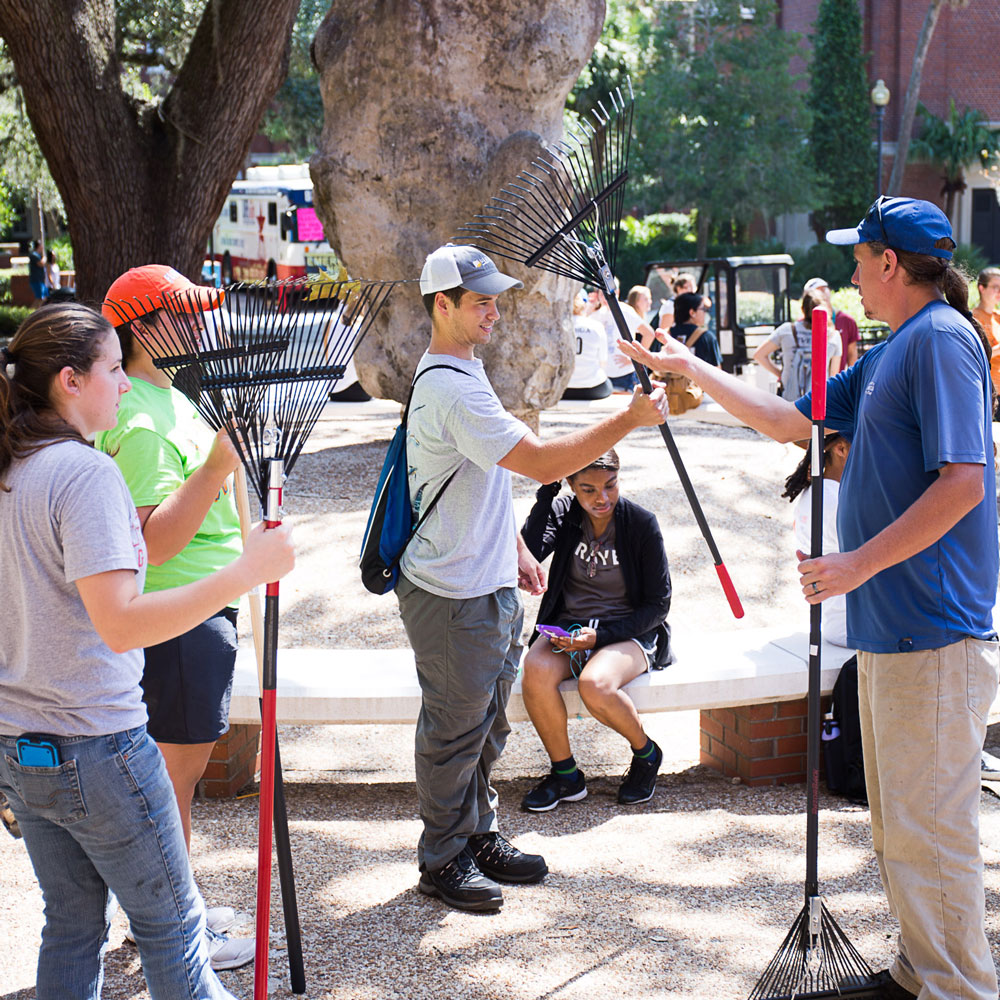
When a Hurricane Irma, as a Category 1 storm, threatened to hit the Gainesville area, the University of Florida community geared up quickly to respond in ways great and small to prepare, support each other, cleanup, rebuild, and give back.
From sheltering 792 students, their families and other evacuees on campus, to volunteer efforts to clean up campus and donate items, to broadcasting vital weather information throughout the storm and its aftermath, here are some of the ways you all contributed to the Gator Good:
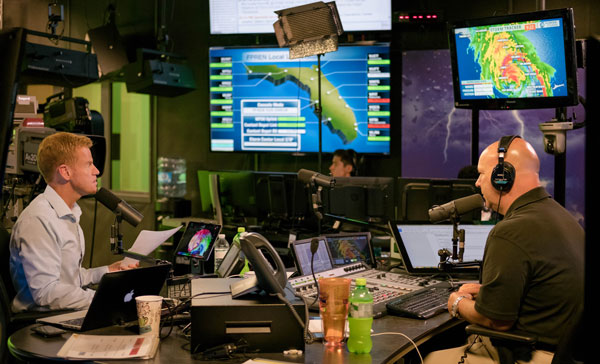
The Florida Public Radio Emergency Network (FPREN), hosted by the UF College of Journalism and Communications and based at WUFT-FM, kept listeners of the 13 public radio stations across the state of Florida informed before, during and after the storm. In total FPREN broadcast hurricane Irma information in every market in Florida including hard hit Miami and Ft. Myers/Naples for more than 81 hours from Friday through Monday. Staff and students worked around the clock to provide the latest information not only on the radio, but also on Facebook Live, the Florida Storms app and other social media platforms. They include meteorologists Jeff Huffman, Cyndee O’Quinn, Harrison Hove and host Randy Wright, executive director of the Division of Media Properties at the UF College of Journalism and Communications. The Florida Public Radio Emergency Network is the brainchild of Randy Wright, who won an Innovator Award for Public Media Advancement in 2015 from the University Station Alliance.
UF/IFAS provided a full range of information on a blog and via the news media, covering the impact on agriculture and citrus, and what to do with storm-damaged trees.
At extension offices such as the UF/IFAS Ft. Lauderdale Research and Education Center, wildlife scientists had to secure vehicles, trap cages, air boats, house boats and trailers to prevent damage. Aquatic weeds scientists and horticultural scientists had to prepare greenhouses and glasshouses, tie down potted plants, check tanks and remove potential flying debris. Entomologists secured Africanized honey bee hives in a protected bee yard and termite cultures in their labs.
Estimates of damage to IFAS property and research statewide have yet to be finalized.
“While millions of Florida residents evacuated in advance of Hurricane Irma this weekend, many others stayed behind to make sure that some of the state’s most delicate animals stayed safe,” read the top paragraph of a story in BuzzFeed about employees at the Florida Museum of Natural History “carefully capturing” the winged wonders in the Butterfly Rainforest.
The story was ranked as No. 12 in the “Just 15 Heartwarming Moments from Irma that Will Remind You of the Good in Everyone.”
UF administration opened two on-campus shelters for students and their families at Steinbrenner Band Hall, and when it reached its capacity of 205, to the Southwest Recreation Center. Overall, UF provided shelter for 792 members of the UF community and general public. Southwest Rec, the Reitz Union, and Housing have all provided space for UF staff and faculty to have a place to shower if they are in need due to outages at home.
Rhonda Black, departmental secretary in the department of Geography at the College of Liberal Arts and Sciences for 16 years, volunteered to work at the shelter in Steinbrenner Hall. She sent her dean David Richardson a note: “Wanted to give you some good news. As a volunteer at the Steinbrener campus shelter since 7 am Sunday morning, I can say first hand that the over 200 students, faculty, retired faculty, staff and families were well taken care of and often remarked at how pleasant the workers were and what a positive experience they had under these potentially dire conditions.
There were no incidences (not even a stubbed toe) and we never lost power. All the persons who came to the shelter were all accounted for and left happy and appreciative this afternoon. Many had experienced hurricane and shelter situations before and said this was by far the most pleasant and well organized group of staff (EMTs, nurses, volunteers, mental health professionals, etc.). The staff from classic fare Catering was prompt, on point and in very positive spirits for all of the meal deliveries. As many of the people left the shelter they asked if we could do this again sometime as a reunion!”
Black, who has assisted for the Crisis Center and the American Red Cross, knew to bring her balloon animal kit to the shelter to calm the younger evacuees. It was some of the adults, however, that were feeling anxious, so she enlisted the children’s help to design alligator balloons with facial expressions and give them names like John the Brave. “After a 5-year-old hands you their balloon animal and says everything will be alright, it is not hard to relax,” she said.
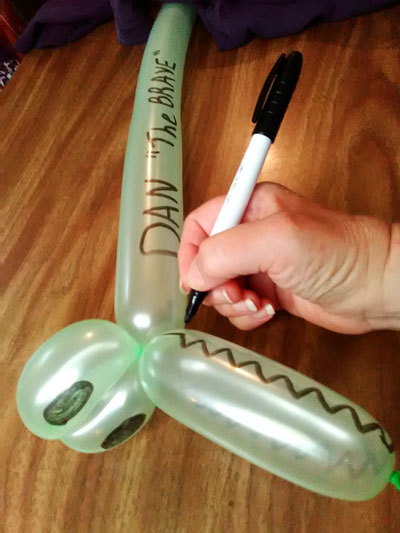
A lift from the Gator in Chief
Freshmen roommates Victoria Lehoczky and Stamatina Copulos found no buses running, so they decided to walk the two and a half miles from their dorm in Thomas Hall to SW Rec shelter. While on foot and walking in the rain with their suitcase and pillows, they were stopped by President Kent Fuchs, who asked if they wanted a ride to the shelter. “It was so surprising, and it was nice to know that the president of the university was spending his time helping students get to safety,” Copulos told the Independent Florida Alligator.
Two acts of selflessness
After a woman who was 8 months pregnant was involved in an accident on I-75, she was treated and released from the Shands Hospital and transported to the Southwest Recreation Center. Ultimately, according to University Relations AVP Janine Sikes, who rode out the storm on the job in the campus Emergency Operations Center, our Housing staff provided her with bedding and supplies and she and her husband were given accommodations in one of the available rooms in Tanglewood Village. No baby was delivered during her stay, but the expectant mother was in good health when she departed.
“Additionally, we received word that about 190 students, mostly international students, had been asked to leave their apartment complex during the storm. Most did not have vehicles and the city’s bus service had stopped running. The UF Police Department coordinated with the city of Gainesville to arrange RTS buses to drive them to the shelter and then home again once the storm was over,” added Sikes, who was responsible for sending out 13 UF Alerts before, during and after the storm to keep the Gator community informed.
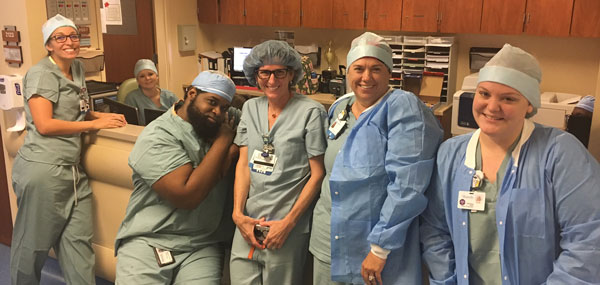
More than 1,500 health care team members from UF Health hospitals and the UF colleges of medicine in Gainesville and Jacksonville responded with precision, composure and determination to ensure patients received needed care and emergency rooms remained open.
“Hurricane Irma tested of our abilities to continue providing health care during a critical situation,” said Michael L. Good, MD, dean of the UF College of Medicine. “Everyone came together as a most impressive team and rose to Irma’s many challenges. We are extremely proud of our faculty, residents, nurses, health care professionals and support staff who took time away from their families to care for our patients and their families through the duration of this storm.” To read more about UF Health activities during the storm, visit http://news.drgator.ufl.edu/2017/09/13/uf-health-teams-help-hundreds-of-patients-weather-hurricane-irma/
The Office of Student Financial Affairs has been reaching out to all students who may have financial issues related to the storm in order to offer emergency financial assistance. More than 40 students have reached out for help. If you are in need, visit Criser Hall, Room S107.
Student Affairs administration kept parents and family members updated through the Gator Parent and Family Association, and also modified Fall Family Weekend in order to minimize costs. By waiving all registration fees for the Blue Fall Family Weekend Packages for those impacted by Hurricanes Harvey and Irma, costs are being donated to the Gator Parent and Family Association Fund, which assists students in a variety of ways, including crisis recovery.
Gator aid for faculty and staff, and a way to donate to those in need
Human Resource Services is stepping up to help faculty and staff experiencing a temporary financial hardship due to the storm through “Aid-a-Gator” emergency funding. This money is intended to be a grant, not a loan, to help our faculty and staff who have been hardest hit by the storm and its aftermath.
From HR: “While the SEC is providing the University with some limited seed money for this program, many faculty and staff, who were more fortunate during the storm are looking for ways to help their colleagues and the campus community. Faculty and staff are encouraged to make donations to this program, so as many employees as possible can receive assistance.
The sense of duty to help our colleagues during this time of crisis is part of who we are. By making a donation, even a small one, this program can help even more members of the Gator Nation who are in need of assistance. Please click here to donate now.”
Other ways to volunteer: Gators Volunteer, Volunteer Florida, and by getting involved in or donating food to the Field and Fork Pantry.
The David and Wanda Brown Center for Leadership and Service and Facility Services brought the #GatorGood spirit to campus by hosting a volunteer campus clean-up from Hurricane Irma. Over three days, 200 students volunteered to remove fallen branches and debris.
At the Levin College of Law, several student organizations planned events to raise money for hurricane relief, including the UF Law Latino Law Student Association, hosted a Brazilian Boot Camp for a Cause on Saturday, with donations for the American Red Cross efforts in the Caribbean islands. Aid drives on campus and at local retailers are in the works.
At the football game Saturday versus Tennessee, the Florida team wore a special helmet decal to honor those affected by the storm, and all those who responded and volunteered their time to help evacuees and victims. Hundreds of UF student-athletes’ families and friends were directly affected by Hurricane Irma.
Getting our fans in the game
UF and UAA teamed up to ask everyone who is able to make donations to help victims of Hurricane Irma to do so to the “One America Appeal” fund, which includes the Florida Disaster Fund. It is the state’s official, private fund established to assist local communities. The Florida-Student Athlete Advisory Committee organized a donation drive for fans attending the soccer match and volleyball matches. They collected clothing items, non-perishable food items, toiletries and blankets for donation.
Thanking our city responders
Athletic Director Scott Stricklin and other coaches and officials teamed up with the City of Gainesville to host a breakfast for responders who have worked tirelessly in the aftermath of the storm.
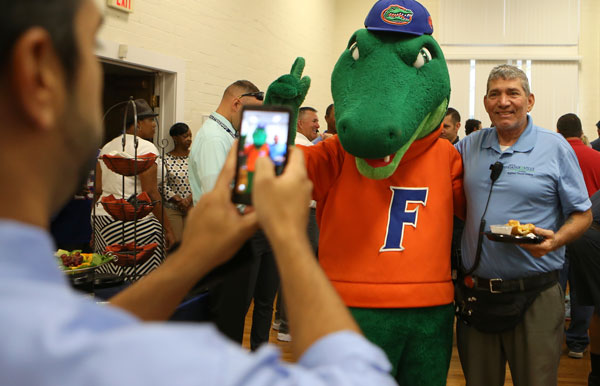
Photographer: Courtney Mims
Wertheim College of Engineering professor Forrest Masters used the storm as an opportunity to do research on how to minimize damage to buildings by measuring wind speeds. Masters mobilized The Hurricane Research Team of engineers, and even reached out to University Communications to invite photographers Bernard Brzezinski and Lyon Duong to join his team to film the convoy of researchers who went to collect data at four sites as the storm made landfall. They shared this video showing the team's work:
While out in the (wind) field, Masters was also interviewed live on The Weather Channel about the team’s research.
![]()
Many other members of the faculty provided their expertise to national media, including:
Ted Kury, director of energy studies for the Public Utility Research Center at UF, in the Washington Post about putting power lines underground: https://www.washingtonpost.com/news/post-nation/wp/2017/09/12/florida-struggles-with-top-job-in-irmas-wake-restoring-power-to-millions/
Associate professor of geography Corene Matyas, who studies hurricane frequency, comments on the statistical likelihood of the U.S. being hit by a hurricane at the climatological peak of this year’s hurricane season in the Dayton Daily News: http://www.mydaytondailynews.com/news/epic-storms-put-nation-response-teams-test/
Meggen Sixbey, associate director and clinical associate professor of UF’s Counseling and Wellness Center, talked to the New York Times about the high anxiety levels this storm produced: https://www.nytimes.com/2017/09/14/us/florida-stress-storm-aftermath.html
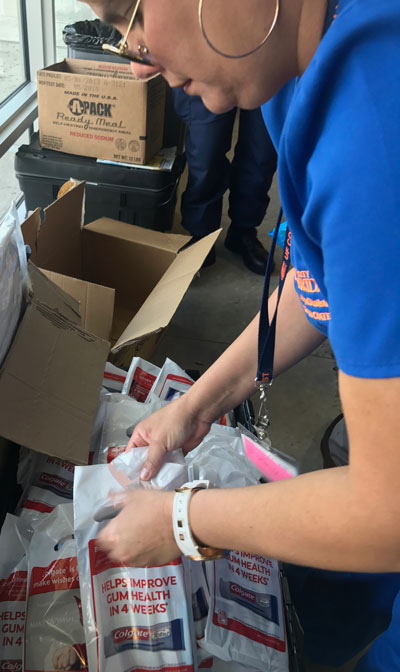
Staff and faculty at the UF Hialeah Dental Center in Miami staff prepared for the storm by placing equipment in storage on Sept. 7. On Sept. 13, their equipment was returned and the group collaborated to clean up the facility in and outside. The clinic is already seeing patients, has resumed a full schedule. When the Department of Health asked the clinic to donate some hygiene items to special needs and elderly individuals displaced by the storm in Monroe County who had evacuated to shelters at Florida International University, the faculty and staff again jumped into action, assembled the bags, and went to a family shelter with children’s items.
Fortunately, the UF Gainesville campus never lost power and no buildings sustained structural damage, but the campus natural beauty was impacted, with an estimated 40 trees down.
One of the trees lost was a campus landmark, the beloved centuries-old live oak tree in front of the new physics building. When the physics department built the building in 1998, they planned to remove the tree and build closer to the road. However, there were some protests which resulted in the building being designed around the tree, according to Pam Marlin, academic assistant at the department of physics. “By preserving the tree, the life was extended nearly 20 more years. The tree had metal support around it, which of course snapped when the tree fell. The first section of the tree fell around 1 a.m., and the rest fell around 4 a.m. on Monday morning,” she said, adding that one student used the following to describe the tree sound when it fell at 4 a.m., “I heard the sound of ripping roots and stretching wood.”
A Facebook virtual event page was created by third-year sociology student Livia Ledbetter to “Mourn the UF Physics Building Tree” https://www.facebook.com/events/2040353722851186/
“I first saw what happened to the tree on Snapchat, and it kind of broke my heart,” said Ledbetter, who added that she never had class in the Physics building, but as a Machen Florida Opportunity Scholar, has attended events there. “I pass by the area [at different hours of the day] and the sight of it made me feel peaceful and happy. I just love the breathtaking nature on campus.” She was moved to create an online space for people to find out about the tree and “mourn it collectively,” and has been surprised by how many alumni reacted to the event and shared their own photos and memories of the tree on Facebook. Over 2,000 people liked or were interested in her Facebook post.
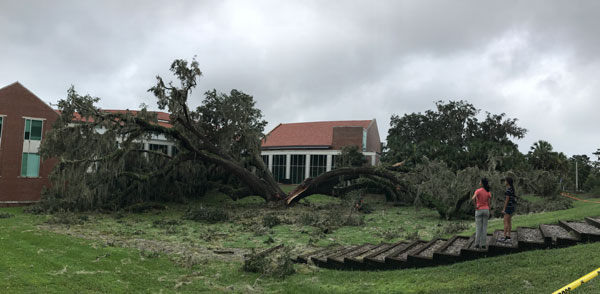
Before, during and after Irma, the UF Veterinary Hospital provided continual emergency services to pets, horses and wildlife, and served as a valuable community resource in light of closures of nearly every other veterinary specialty and emergency hospital in the state.
The UF Veterinary Emergency Treatment Service, at the request of Alachua County officials, traveled to and picked up 100 dog crates in Bushnell and delivered them to Alachua County Animal Services’ operations to support pet-friendly shelters in the area. In addition, the UF VETS team is investigating complaints of abandoned horses in Ocala, and is assessing the situation in Key Largo.
Here in Alachua County, the UF Shelter Medicine Team has helped support Alachua Humane Society’s efforts to move animals out of shelters in harm’s way. The shelter medicine team and associated volunteers have also redistributed vaccines and flea and tick preventive medication for 800 animals to the ACHS and have assisted in arranging relocation transports to Chicago, Atlanta and South Carolina. At the request of Florida’s State Animal Response Coalition, UF has worked through difficult communications networks to contact each of Florida’s 155 animal shelters to assure that they are connected with their county’s emergency operations centers and are getting the help that they need.